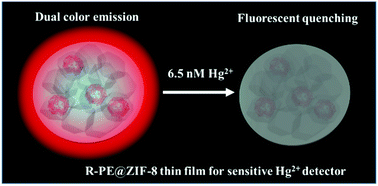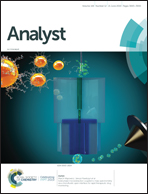R-phycoerythrin proteins@ZIF-8 composite thin films for mercury ion detection†
Abstract
Mercury, as one of the most prevalent toxic metals released by various natural and anthropogenic processes, causes severe pollution of soil and groundwater. In this work, R-phycoerythrin (R-PE) proteins encapsulated into ZIF-8 composite thin films were prepared via a solid-confinement conversion process and applied as fluorescent sensors for mercury ion detection. The R-PE proteins encapsulated into ZIF-8 exhibit dual color emissions including green (518 nm) and red (602, 650 nm) fluorescence, while the original orange emission (578 nm) of pure R-PE is significantly suppressed. R-PE@ZIF-8 presents excellent selectivity and sensitivity for mercury detection in a large pH range without buffer solution. Under the optimal conditions, there is a good linear relationship between the fluorescence quenching efficiencies of R-PE@ZIF-8 and logarithmic concentrations of mercury ions in the range of 0.001–50 μM with the detection limit (LOD) of 6.7 nM much lower than the guideline value given by the World Health Organization. Furthermore, multi-peak detection of R-PE@ZIF-8 improves the detection accuracy of Hg2+ concentration.



 Please wait while we load your content...
Please wait while we load your content...